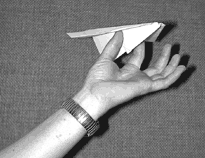
A paper plane ready to glide.

A paper plane ready to glide.
Introduction
A paper airplane falls down due to gravity and glides forward through the air at the same time. We'll measure the glide ratio the ratio of the distance glided to the distance fallen.
Material
Assembly
Fold a paper plane. (See the plans on my site for the Nakamura Lock or in the Online Exploring Paper Magazine published by the Exploratorium.)
To Do and Notice
Fly your paper plane. Trim it until it glides in a straight line smoothly to the floor.
All paper airplane gliders have a natural speed and angle at which they will steadily glide down to the ground. Fly them too slowly and the nose will drop and the plane will dive, fly them too fast and the nose will rise and the plane will climb or stall.
If you cannot find any speed to keep the nose from falling into the ground bend the back of the wing up.
If the nose points up and then stalls at all speeds bend the back of the wing down.
Practice and learn to throw your plane at the exact right speed and angle so that it will smoothly fly to the ground.
We call this the Goldilock's throw, not too fast, not too slow, just right.
Stretch a string, horizontally, just below chin
height.
Measure the height, H, of this string above the floor, perhaps H =
1.5 m.
Launch your plane over this string.
Note the point where the plane hits the floor.
Measure the horizontal distance from the string to where the plane hit the floor, D.
Compute the glide ratio, D/H.
Find an airplane design and trim that gives the best glide ratio.
What's Going On?
As a plane falls under gravity it pushes air backward and down to keep itself aloft and to move forward.
Each different airplane has a different glide ratio.
Even the same airplane when trimmed differently a have a different glide ratio.
So What?
Once it gets up to flying speed, after a 300 m
long drop, the human body has a glide ratio of 1.
That means that if it falls a kilometer it can glide a kilometer
forward.
A modern high performance glider will have a glide
ratio over 40.
It will fly 40 km forward for every kilometer it drops.
|
Scientific Explorations with Paul Doherty |
|
20 October 2000 |